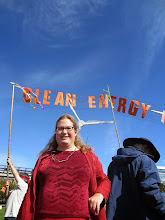Jefferson County Cities Leading the Way on Embracing Solar Energy JeffCo leads state in cities certified as Solar Friendly Golden, CO - Jefferson County communities are going solar in a big way, with nationally-leading policies that save money for their residents and reduce air pollution for everyone, leaders told a crowd of interested citizens Friday. Leading JeffCo cities are installing solar energy on their own facilities to cut energy bills, supporting their residents' desire to go solar, and purchasing thousands of kilowatts of solar energy from community projects. And more projects are planned, they told attendees at the ''Building Community in JeffCo with Solar" on Friday, the first effort to look comprehensively at the cities' accomplishments. The event took place the day before the Golden Tour of Solar Homes on October 4, the only such tour in Colorado this year as part of a national day of solar home tours. While the cities encourage rooftop solar arrays on individual homes, they are also leading backers of community solutions. Jefferson County is home to the National Renewable Energy Laboratory and NREL's Jason Coughlin noted that when the lab opened 37 years ago gas was 62 cents a gallon, and solar power about $100 a watt. "Now a gallon of gas costs more than a watt of solar PV," he said. "And of course, we are so fortunate to be located in Colorado, one of the nation's leading solar states." Four of the county's leading cities: Lakewood, Arvada, Westminster and Golden have been certified as Solar Friendly Communities for steps they have taken to make it faster, easier and more affordable for citizens to go solar. No other county has as many certified cities. Lakewood, the county's biggest city, has installed more than 5,264 kilowatts of solar energy just since 2010 through 719 separate solar projects. The city also purchased 274 more kilowatts of solar energy over a 20-year period from a Community Solar Garden built by Clean Energy Collective in Golden. "Lakewood is developing its first city-wide Sustainability Plan with an emphasis on expanding the use of renewable energy for both it its municipal operations and for its residents, institutions, and businesses," said city council member Tom Quinn, who spoke at the event. "Lakewood's investments in solar energy will help the City get off to a great start in achieving these goals." "Arvada has issued 1,347 solar permits since 2007, with interest increasing dramatically in the past two years," said sustainability coordinator Jessica Prosser. "The city has more than 800 kW of solar mounted on city buildings and has purchased another 600 kW of solar from a SunShare Community Solar Garden," she added. Westminster, located partially in Jefferson County, became Colorado's first platinum-level Solar Friendly Community last summer in recognition for its many efforts to streamline solar permitting. The city has also purchased significant electricity from a SunShare Solar Garden.
Golden has opted to install its own solar projects and the city has spent $3 million on eight different projects on city facilities so far. They include the 90-panel solar thermal system heating the swimming pool at the community center and 600kW in PV solar arrays on other city facilities, with another project planned soon.

Solar thermal array on the Golden Community Center Clean Energy Collective, which has built two Community Solar Gardens in Jefferson County -totaling 686 KW -reports overwhelmingly positive response. SunShare, another Community Solar developer, has also found strong interest in Jeffco and Friday announced the building of another 1.5 MW Solar Garden outside Golden near White Ranch. The current Solar Garden is more than 85% sold-out, SunShare said, with three municipal customers and dozens of homeowners. "We are thrilled to be a part of these communities' success - it is leadership like that shown from each of the cities and citizens choosing to participate in our Jefferson County Solar Garden and other innovative solar programs that will drive greater adoption of renewable energy across the state," said Marc Bencivenni, Vice President of SunShare. With the requirement that five percent of the energy go to low-income residents, CEC forecasts that its facility will deliver more than $120,844 worth of clean energy to residents over the program's 20-year term. SunShare similarly estimates its facility will deliver more than $225,000 worth of clean energy to low-income residents in Jefferson County. "Jefferson County is also home to many solar thermal systems, which offer an attractive return on investment especially to propane and electric heating customers. Capitol Solar Energy, for example, has installed more than 2,500 kW of power capacity that represents annual savings of nearly $300,000 and avoided CO2 emissions of 1.5 million tons per year. Capitol Solar also services more than 100 older systems in JeffCo and although many are 35 years old they show no sign of wearing out,"said Capitol Solar vice-president Laurent Meillon. Jefferson County, one of Colorado's most populous located on the western side of the Denver metro area, has shown that locally-based decisions on solar energy can make a big difference for residents, said Rebecca Cantwell, Executive Director of the Colorado Solar Energy Industries Association, which organized the event. " Going solar is growing easier and more affordable every day and it just makes economic sense for cities,'' she said. ---- The public is invited to the Golden Solar Tour of Homes starting at 9 a.m. Saturday October 4 at the American Mountaineering Center in Golden, finishing with a reception and green expo from 4 pm to 8 pm at the Center, 710 10th St in Golden. ---  Community Solar Discussion at the Golden Community Center For more information: Rebecca Cantwell, COSEIA, rcantwell@coseia.org, or 303-333-7342 | 






